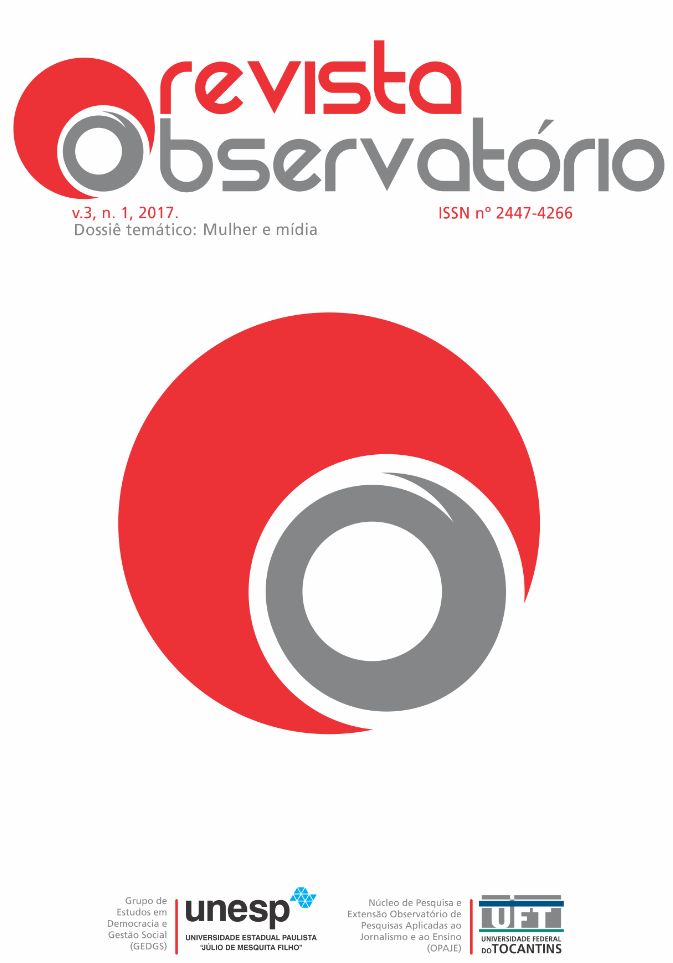CUANDO TODOS LOS COLORES DE LOS CINES SON AZUL, EL COLOR MÁS FRÍO: Un Análisis de las producciones audiovisuales y Género
DOI:
https://doi.org/10.20873/uft.2447-4266.2017v3n1p105Palabras clave:
cine, Teorías de Género, Estadísticas, Estudios poscolonialesResumen
El artículo analiza, entre otros, mediante el estudio de la película Azul es el Color más Caliente (Francia, 2013), las características fundamentales de las producciones audiovisuales eurocéntricas - hegemónicas y dominantes en el escenario mundial - que instigan, perpetran y perpetúan la cancelación y/o la negación de lo femenino. Y ponen raíces en los estereotipos de género que impregnan las diferentes culturas y sociedades globales. Las estadísticas sobre las mujeres que trabajan en producciones audiovisuales y teorías cinematográficas, la imagen en movimiento, y análisis críticos de las teorías feministas del cine se desarrollan como herramientas para la investigación. La imagen es una poderosa herramienta de comunicación, se asemeja o se confunde con lo que es. Imitadora visualmente (mimesis), o la reflexión, pueden conducir al conocimiento, la educación, o engañar. La imagen construida crea asociaciones mentales sistemáticas.
Descargas
Citas
Referências
BARTHES, Roland. Mitologias. São Paulo: Editora Difel, 1982.
GRAINGE, Paul (Edit.). Memory and Popular Film. Manchester, UK: Manchester
University Press. 2003.
IRIGARAY, Luce. This Sex Which Is Not One. Ithaca: Cornell University Press,
Revista Observatório, Palmas, v. 3, n. 1, p. 105-130, jan./mar. 2017
_ .revista
Observatório
ISSN n° 2447-4266 Vol. 3, n. 1, Janeiro-Março. 2017
DOI: http://dx.doi.org/10.20873/uft.2447-4266.2017v3nlpl05
KAEL, Pauline. KLss Kiss Bang Bang. USA & Canada: Little, Brown and Company,
KAPLAN, E. Ann. A Mulher e o Cinema: Os Dois Lados da Câmera. Rio de
Janeiro: Rocco, 1995.
. Looking for the Other: Feminism, Film, and the Imperial Gaze. New
York: Routledge, 1997.
LAURETIS, Teresa de. Queer Theory: Lesbian and Gay Sexualities. Differences:
A
Journal of Feminist Cultural Studies, 3(2), iii-xviii, 1991.
LOURO, Guacira Lopes. O Corpo Estranho. Ensaios sobre Sexualidade e Teoria
Queer. Belo Horizonte: Autêntica, 2004.
MAROH, Julie. Le Bleu DAdele. Disponível em:
https://web.archive.orq/web/20140110123220/http://www.iuliemaroh.com/2013
/05/27/le-bleu-dadele/ Acesso em 20/02/2017.
MULVEY, Laura. Visual Pleasure and Narrative Cinema. Revista Screen, xvi, n.3,
. Visual and Other Pleasures: Theories of Representation and
Difference. Bloomington and Indianapolis: Indiana University Press, 1989.
SONTAG, Susan. Whafs Happening to America? (Simpósio - Vários autores).
Partisan Review, Edição do Inverno, 1967.
. Sobre Fotografia. São Paulo: Companhia das Letras, 2004.
SPIVAK, Gayatri Chakravorty. Can the Subaltern Speak? in Cary Nelson and
Larry Grossberg (Editors). Marxism and the Interpretation of Culture. Urbana:
University of Illinois Press, 1988.
Revista Observatório, Palmas, v. 3, n. 1, p. 105-130, jan./mar. 2017
_ .revista
Observatório
ISSN n° 2447-4266 Vol. 3, n. 1, Janeiro-Março. 2017
DOI: http://dx.doi.org/10.20873/uft.2447-4266.2017v3nlpl05
. Question of Multiculturalism: The Post-Colonial Critic: Interviews,
Strategies, Dialogues. New York, NY: Routledge, 1990.
STAM, Robert & SHOHAT, Ella (Editors). Unthinking Eurocentrlsm. New York,
NY: Routledge, 1994.
SITE ISTO É INDEPENDENTE. Mulheres sob ataque. Edição de I o de março de
Disponível em:
http://www.istoe.com. br/reportagens/279673_MULHERES+SOB+ ATAQUE
SITE MULHER NO CINEMA. Oscar fica #LessWhlte, mas continua #SoMale.
Disponível em: http://mulhernocinema.com/opiniao/oscar-fica-lesswhite-mas-
segue-somale/ Acesso em 27/02/2017.
SITE UOL. Atriz e Diretor de Azul é a Cor Mais Quente Encaram Polêmicas.
Disponível em:
https://web.archive.orq/web/20131207043221/http://cinema.uol.com.br/noticia
s/redacao/2013/12/04/atriz-e-diretor-de-azul-e-a-cor-mais-quente-encaram-
polemicas-por-filme.htm Acesso em 20/02/2017.
THE WASHINGTON POST. Why the Age of 40 is so Important in Hollywood.
Disponível em:
https://www.washinqtonpost.com/news/wonk/wp/2016/Q9/19/these-charts-
revea[-how-bad-the-film-industrvs-sexism-is/?utm term=.0f829869662d Acesso
em 20/02/2017.
WEBARCHIVE.ORG. The Stars of Blue is The Warmest Color on the Riveting
Lesbian Love Story and Graphic Sex Scenes. Disponível em:
https://web.archive.org/articles/2013/09/01/the-stars-of-blue-is-the-warmest-
color-on-the-rivetinq-lesbian-love-sory-and-qraphic-sex-scenes.html Acesso
em 20/02/2017.
WOMEN IN TV AND FILM. It's a Man's (Celluloid) World. Disponível em:
http://womenintvfilm.sdsu.edu/its-a-mans-celluloid-world-portrayals-of-
female-characters-in-the-top-100-films-of-2015/ Acesso em 24/02/2017.
Descargas
Publicado
Cómo citar
Número
Sección
Licencia
[PT] Autores que publicam nesta revista concordam com os seguintes termos:
1. Autores mantém os direitos autorais e concedem à revista, sem pagamento, o direito de primeira publicação, com o trabalho simultaneamente licenciado sob a Creative Commons Attribution License (CC BY-NC 4.0), permitindo o compartilhamento do trabalho com reconhecimento da autoria do trabalho e publicação inicial nesta revista.
Leia todos os termos dos direitos autorais aqui.

